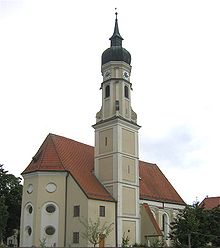St. Peter (Siegertsbrunn)
The parish church of St. Peter is the Catholic village church of Siegertsbrunn (Upper Bavaria).
history
The end of the 17th century is likely to be the origin of today's church of St. Peter. June 17, 1707 is passed down as the day of the consecration of the church. St. Peter is a single-nave complex with a presbytery, which has a three-eighth end. Large windows make the space of the church appear light and bright.
Furnishing
The equipment comes in part from non-Siegertsbrunn, but appears to have been taken over by another church. An inscription on the back of the high altar shows that it was created from the money of the sacrificial stock for the Leonhardikirche and erected there as a choir altar on October 28, 1631, the feast day of St. Simon. Presumably the two side altars were created at the same time and probably also by the same but unknown master. The similarities between the individual altars are the reason for this assumption. It is not clear whether the two side altars were originally set up in the Leonhardikirche. In 1952 the altars were reconstructed as they can be seen today. Until 1952, as in many other places, the sacristy was located behind the high altar, where the priest and the altar boys could change their clothes. Since then there has been an extension to the tower. The side altars were dedicated to the Three Kings and Saint Anthony of Padua. Due to the patronage, the high altar had the holy prince of the apostles Peter as patron saint. Today the high altar houses a statue with the mother of God Mary with the baby Jesus, the left side altar is dedicated to the holy helper Barbara and the right side altar shows the martyrdom of St. Achatius .
The high altar is clearly and strictly structured. The decoration is still limited to the bare essentials. The original central figure, St. Peter, was removed in 1952. It was just a copy from the 19th century. The image of the Mother of God, Mary, is a late Gothic sculpture. The face of Mary radiates grace. Her robe falls to the floor in rich folds, she holds the child in her right arm. The holy bishop Benno von Meißen (old Bavarian patron) and the holy Pope Sixtus are added to the high altar as assistant figures. In the excerpt, God the Father can be seen, who raises his right hand in blessing.
The left side altar shows Barbara seated on a bench with a goblet in her right hand; she wears a crown on her head. Her father can be recognized at the martyr's feet. This wooden sculpture is also an excellent work of the late Gothic. The martyrdom of St. Achatius is shown in the right side altar. Achatius was the leader of ten thousand Christians. Because of their faith they had to die the death of the witnesses and were thrown from a high rock into a ravine and pierced by thorns.
A very beautiful, late Gothic statue of Peter rises above the entrance to the sacristy. Christ's representative sits almost majestically on his throne. The cross on the left choir wall reminds the community of the popular mission in 1761. The frescoes in the presbytery show scenes from the life of the Apostle Peter. In the large ceiling fresco, Christ hands over the power of the keys to Peter. Presumably Augustin Demmel, who worked in the Leonhardikirche in 1785, did the painting. The nave was painted much later. Anton Ranzinger and Oskar Wieleitner made it in 1912. The ceiling fresco shows the martyrdom of St. Peter, the crucifixion of Peter.
On the north wall of the nave is the pulpit with the year 1681; the baroque decorations are kept clear and easy to understand. For the dating, the year may give an indication that at this time the walls were already in place and St. Peter's Church was already vaulted, so that the interior decoration could begin this year. Opposite the pulpit, the two emergency helpers Katharina and Barbara can be seen almost life-size. A figure of St. Leonhard was published on the north wall of the nave. It was probably made around 1500. This sculpture was on the high altar of St. Peter until 1952.
literature
- Georg Paula , Timm Weski: District of Munich (= Bavarian State Office for Monument Preservation [Hrsg.]: Monuments in Bavaria . Volume I.17 ). Karl M. Lipp Verlag, Munich 1997, ISBN 3-87490-576-4 , p. 120-122 .
Web links
Coordinates: 48 ° 1 ′ 17.1 ″ N , 11 ° 43 ′ 44.9 ″ E
